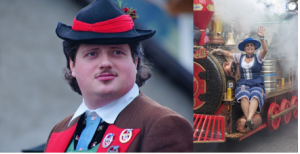🙅♀️German Level 4, Activity 13: Stereotypen / Stereotypes (Face to Face)

Description: Students discuss German stereotypes.
Semantic Topics: Stereotypes, Typisch, Prejudice, Vorurteil, Adjectives, Adjektive.
Products: Cultural clichés, Kulturklischees.
Practices: Understanding cultural clichés about people in German speaking countries. Kulturklischees über Menschen im deutschsprachigen Raum verstehen.
Perspectives: Danger in stereotyping people. Value of cultural individualities of German speaking lands. Gefahr, Menschen zu stereotypisieren. Wert kultureller Individualitäten im deutschsprachigen Raum.
- Standard 2.1 Students demonstrate an understanding of the relationship between the practices and perspectives of the cultures studied.
- Standard 3.2 Students acquire information and recognize the distinctive viewpoints that are only available through German and the German-speaking world.
Idaho State Content Standards:
- Objective: CLTR 1.2 Explain the relationship between cultural practices/behaviors and the perspectives that represent the target culture’s view of the world.
- Objective: COMM 2.1 Understand, interpret, and analyze what is heard, read, or viewed on a variety of topics.
NCSSFL-ACTFL Can-Do Statements:
- I can discuss stereotypes of German speaking countries.
- I can discuss stereotypes of my own culture.
- I can form an opinion about the validity of certain stereotypes.
Materials Needed:
Warm-Up
Read the stereotypes and discuss whether the stereotypes are correct.
Lest die Klischees und besprecht ob die Klischees stimmen.
Main Activity
Instructions in English/Deutsch
- Stereotype 1: The Germans eat bratwurst, beer, and potatoes.
Klischee 1: Die Deutschen ernähren sich von Bratwrust, Bier, und Kartoffeln.
- Conclusion: The stereotype is true and tastes good!
Fazit: Klischee stimmt und schmeckt!
- Stereotype 2: The Germans are cold, unfriendly and inconsiderate.
Klischee 2: Die Deutschen sind kalt, unfreundlich, und rücksichtslos.
- Conclusion: The Germans are very nice and helpful, even in a big city like Berlin. Stereotype refuted.
Fazit: Die Deutschen sind sehr nett und hilfsbereit sogar in einer Großstadt wie in Berlin Klischee widerlegt.
- Stereotype 3: The Germans are humorless and stiff.
Klischee 3: Deutsche sind humorlos und steif.
- Conclusion: The Germans are full of humor and not stiff. They like jokes and are very funny. Stereotype refuted.
Fazit: Die Deutschen sind humorvfoll und nicht steif. Sie mögen Witze und sind ganz lustig!
- Stereotype 4: The Germans love order and adhere to rules.
Klischee 4: Die Deutschen lieben Ordnung und halten sich an Regeln.
- Conclusion: Stereotype true. The Germans love order and adhere to the rules.
Fazit: Klischee stimmt! Die Deutsche haben viele Regeln und halten sich daran.
- Stereotype: The Germans love soccer!
Klischee 5: Deutsche lieben Fußball!
- Conclusion: World Champions 1954, 1990, 2014.
Klischee Richtig!
- In summer, there is barbecue and soccer.
Fazit: Weltmeister: 1954, 1974, 1990, 2014 Klischee stimmt! Im Sommer gibt’s Grillen und Fußball.
Wrap-Up
Discuss any new information the students learned about German stereotypes.
Besprechen Sie alle neuen Informationen, die die Schüler über deutsche Klischees erfahren.
End of activity:
- Read Can-Do statements once more and have students evaluate their confidence. (Use thumbs up/thumbs down)
- Encourage students to be honest in their self-evaluation.
- Pay attention, and try to use feedback for future activities!
NCSSFL-ACTFL Can-Do Statements:
- I can discuss stereotypes of German speaking countries.
- I can discuss stereotypes of my own culture.
- I can form an opinion about the validity of certain stereotypes.
cultural resources
Attached is a link from Meet the Germans, What do Foreigners Think about Germans.
How to Remix a Pathways Project Activity
Feeling creative? The Pathways Project needs your help in remixing activities for the K-12 classroom.
Try taking an activity to the next level by:
- Add new content (something you’ve created or another OER source)
- Contribute additional activity suggestions
- Integrate authentic materials such as videos, infographics, photos, etc.
- Suggest how to implement the activity in the classroom
- Customize the content for a specific audience or group of learners (for example, K-5 learners or to differentiate for student’s needs)
We want to make it easy to share back with the larger Pathways Project Community! Simply, click this link to remix this activity.
Please consider sharing your remixed activity with us by emailing the activity link to Pathwaysproject@boisestate.edu so that Pathways continues to grow!

